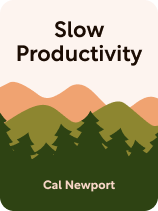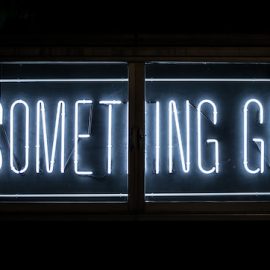

This article is an excerpt from the Shortform book guide to "Slow Productivity" by Cal Newport. Shortform has the world's best summaries and analyses of books you should be reading.
Like this article? Sign up for a free trial here.
Are you feeling overwhelmed by your workload? Do you wonder if there’s a better way to approach your tasks?
Cal Newport’s second principle of slow productivity offers a refreshing perspective on work. It emphasizes working at your own pace in a natural and sustainable manner. This approach recognizes that meaningful achievements take time and can’t be sustained through constant activity.
Keep reading to discover five practical strategies for implementing this principle and creating a more balanced, productive work life.
Work at Your Own Pace
Newport’s second principle of slow productivity emphasizes working at a natural and sustainable pace. This approach, more similar to a pre-industrial rhythm of work and rest, recognizes that meaningful achievements take time and can’t be sustained through nonstop activity. According to Newport, working at your own pace in a way that respects your individual needs and natural rhythms produces more significant and meaningful results.
| How to Institutionalize a Balanced Work Culture To systematically integrate “working at a natural pace” into work culture, we can draw inspiration from countries and companies that have institutionalized work-life balance. In Germany, for example, the Arbeitszeitgesetz (Working Hours Law) limits weekly work hours to prevent overwork, and the cultural practice of “Feierabend” emphasizes post-work rest and leisure, allowing employees to fully disconnect from job-related stress. Additionally, Germany offers generous public holidays and annual leave, encouraging extended breaks for recovery and relaxation. These policies foster an environment that respects natural work rhythms and prioritizes employee well-being. Research supports Newport’s claim that prioritizing rest and time away from work improves productivity. For example, a study on a four-day workweek found increased job satisfaction, improved work-life balance, reduced stress, enhanced product quality, and better customer service. Post-trial, employees continued to experience lower stress levels, reduced burnout, and better physical and mental health. By taking a cue from these practices, workplaces can create a balanced and sustainable work culture that enhances productivity and improves overall employee satisfaction and well-being. |
To implement this principle, Newport suggest several strategies.
#1: Keep It Simple
Don’t jam-pack your day with tasks. This helps keep stress at bay and makes sure you’re not overwhelmed by a never-ending to-do list. For example, if you usually list 15 tasks for the day, try limiting it to the top five priorities. (Shortform note: In addition to limiting your weekly to-do list, consider incorporating a “weekly review,” a tool introduced by David Allen in Getting Things Done. In the weekly review, you look back on your tasks and accomplishments from the week to get a big-picture view of what’s going on in your life. The weekly review not only allows you to see what you’ve accomplished but also helps you plan what’s most important for the next week.)
#2: Give Yourself More Time
Don’t rush. Newport says you should allocate more time than necessary to complete a task or project. This way, you can dive deeper into your work without feeling rushed. For instance, if you estimate a report will take three days, schedule it over five days to allow thorough research and revisions.
(Shortform note: To better understand how long projects take, productivity expert Laura Vanderkam, author of 168 Hours, suggests tracking your time meticulously for a week or two as a method to accurately estimate how long tasks actually take. By analyzing this data, you can identify patterns and realistic time frames for different activities. Vanderkam emphasizes the importance of being honest with yourself about how long tasks take, rather than how long you plan for them to take. This approach helps you create more accurate schedules and avoid the pitfalls of overly optimistic time estimations.)
#3: Take Breaks With the Seasons
Newport recommends that just as farmers rest in winter, you should plan times during the year when you’ll slow down, rest, and reflect. He explains that it’s natural to have ups and downs in productivity; these downtimes are important because they can help refill your creative tank. For example, you might choose to designate summer months for lighter projects and personal development, reserving intense work for other times of the year. (Shortform note: While Newport doesn’t advocate resting in any particular season, Katherine May, author of Wintering, suggests that the winter months are a natural time for rest and retreat. She argues that winter, with its longer nights, colder temperatures, and sparser natural growth, provides an intuitive invitation to slow down, turn inward, and allow yourself to rest.)
#4: Make Your Workspace Yours
Newport says that your environment should help you focus, not distract you with clutter or discomfort. Whether it’s pictures that inspire you or a certain type of music that gets your ideas flowing, customize your workspace to encourage focus and creativity.
(Shortform note: Not everyone agrees on what kind of space inspires focus and creativity. Some creative professionals recommend filling your space with things that stimulate you. For example, Austin Kleon, author of Steal Like an Artist, advocates decorating your workspace with sources of inspiration, like quotes from favorite authors or specific art pieces. However, writing coach William Zinsser, author of On Writing Well, argues that the best creative work is done in the simplest spaces. As an example, he highlights a photograph of E.B. White writing in a simple boathouse with nothing but a typewriter and a wastebasket.)
#5: Create Meaningful Routines
Start rituals around your work habits—maybe lighting a candle before brainstorming sessions or taking three deep breaths before tackling emails—to signal to yourself that it’s time to concentrate deeply or think creatively. (Shortform note: In Deep Work, Newport also stresses the importance of implementing a closing ritual when you wrap up your work for the day. When you create a shutdown ritual, instead of feeling anxious about unfinished tasks, you’ll feel confident that all the important tasks are accounted for, and that you’ll make meaningful progress the next day. This gives you more time to fully relax in your time off from work.)

———End of Preview———
Like what you just read? Read the rest of the world's best book summary and analysis of Cal Newport's "Slow Productivity" at Shortform.
Here's what you'll find in our full Slow Productivity summary:
- The flaws with the traditional definitions of productivity
- The principles of Cal Newport’s “slow productivity”
- Why doing less actually means you’re doing more






